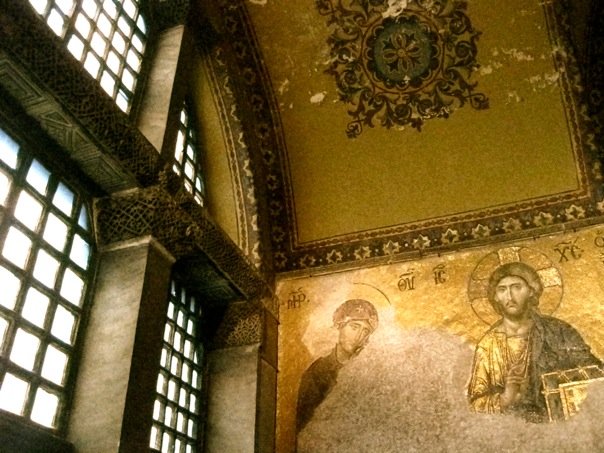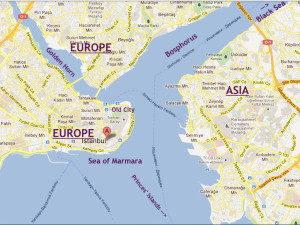This is second in a five part series of ‘Istanbul Tips’: Planning a visit, Orienting yourself on arrival (this one), Restaurant & Entertainment Highlights, Settling in for the longer term, and Getting a residence permit. I wrote this in conjunction with the wonderful Kate Bloomer.
This probably isn’t fun to digest in one sitting. I suggest printing this out and reading it on the plane ride over or keeping it as a reference to read when you’re stuck in traffic (because this is Istanbul, and you will be at some point). A concise version (no pictures) can be downloaded as a PDF here. Topics covered:
Airport Arrival
Airport Arrival
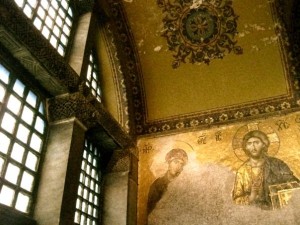 |
| Mosaics in Aya Sofya (Haghia Sophia) |
Orientation
- Geography
- Currency
- Phone
- Internet
- What to wear
- Language
Places to Go
- Sights
- Socializing
Getting Around
Turkish language basics
Exploring the rest of Turkey
Airport Arrival
- Americans and Europeans will have to buy a visa on arrival – it’s just a sticker that you buy directly before you go through passport control. You’ll need $20 or 15 euro or 10 British pounds IN CASH handy to pay for the visa. Visitors from other countries will probably have to arrange a visa in advance.
- There are a number of ATMs and exchange counters with near-market rates by baggage claim and after you exit customs, so no need to exchange money in advance. The currency is the Turkish Lira (TL).
- Getting into the city will depend where you are staying (probably Sultanahmet or Beyoğlu/Taksim) and at which airport you arrive (Atatürk or Sabiha Gökçen).
- Atatürk to Taksim
- Fastest: a taxi will take 30-40 minutes barring traffic and should cost around 40 TL. ***Cabs are extremely unreliable, and love to take tourists on 100 TL+ joyrides around Istanbul instead of to their destinations. Make sure you know exactly where you’re going (a map printout would be useful) and discuss about how much it will cost beforehand.***
- Easiest: Catch a Havaş/Havataş bus – these clean and comfortable coach buses are usually directly in front of you when you exit the terminal. It will take you to Taksim, the second and last stop, in about 40 minutes for 10 TL or 5€ or $8. From Taksim it’s easy to get anywhere in Beyoğlu.
- Cheapest: You can take the metro to Zeytinburnu, catch the tram to Kabataş, and then the funicular to Taksim, for a grand total of 6 lira (you’ll have to buy a different 2 TL token for each stage of the journey). Unless you’re extremely tight on cash, paying an extra 4 lira for the Havataş bus is much more convenient.
- Atatürk to Sultanahmet:
- A cab shouldn’t cost more than 30 TL, though keep in mind the advice about cabs above.
- Take the metro (2 TL) to Zeytinburnu and then the tram (2 TL) to whichever stop is closest to your hotel (probably Sultanahmet). You’ll have to buy a different token for each type of transport, so don’t bother getting two at the beginning.
- Sabiha Gökçen to Taksim:
- Fastest & Easiest: Again the Havaş/Havataş bus, but it takes a little longer (about an hour) and costs 12TL/6€/$10. They run 25 minutes after the arrival of every plane.
- Cheapest: E10 bus to Kadiköy and then a ferry to Kabatas for 4TL. This will not work if you are arriving at strange hours, but is pretty reliable outside of that.
- A taxi will cost at least 70 TL, and possibly much more if you’re stuck in traffic. It’s no faster than the bus so I really wouldn’t recommend taking one.
- Sabiha Gökçen to Sultanahmet:
- Hotel shuttle is probably easiest – if it’s exorbitant take the Havaş to Taksim and cab it from there.
Orientation:
- Geography of Istanbul:
- The Bosphorus runs roughly south-north between the Sea of Marmara (bottom) and the Black Sea (at the top). The Golden Horn, aka the Haliç, is a river/strait that intersects it at a right angle on the ‘European’ side and so divides the western half of Istanbul into Old Istanbul (also known as the Golden Horn, confusingly) in the south and modern Istanbul (Beyoğlu) above. The main artery of modern Istanbul is a street called Istiklal Caddesi, which runs from Taksim Square southwest to the Galata Tower, near the southern tip of Beyoğlu. The Galata bridge takes you from the southern tip of Beyoğlu, across the Goldern Horn (body of water) to the Golden Horn (peninsula). From Taksim, a funicular will take you down to the edge of the Bosphorus at Kabataş, and the Taksim/Kabataş axis marks the top of Beyoglu. Further north, two bridges cross the Bosphorus to connect the European and Asian side, the Boğaz bridge and the Fatih Sultan Mehmet bridge – more commonly, less creatively, known as the First and Second Bosphorus bridge.
- Currency
- Roughly, $1 = 1.7 TL and 1€ = 2.3 TL and £1 = 2.8 TL
- ATMs and money-exchange places are easy to find throughout the city – look for the sign saying ‘Doviz’ for the latter. Almost all of them have very fair rates – just look for something with less than 5 cents spread between the listed buy and sell price.
- Phone
- The country code is +90. Cell phone numbers start with (0)5 (drop the zero if calling from an international phone) and land lines in Istanbul start with (0)212 (European side) or (0)216 (Asian side)
- It is difficult to pick up a Turkish SIM for a short stay – it takes about 24 hours to register, and then will stop working within a week (sometimes more, sometimes less) unless you go through an extensive registration process with your passport. SIM cards are also needlessly expensive (50 TL or more). If you have a phone with international roaming capabilities, it should work and is probably the easiest option.
- Internet:
- There is free wireless in most cafes (though you may have to ask for the password).
- What to wear:
- You can dress exactly as you would in the US or Europe. You are a tourist, so you will be heckled no matter what you wear.
- To go into mosques, you must take off your shoes, so if you plan to do a lot of sightseeing you might want to bring something easy to slip on and off. Women need to cover their head, shoulders, and legs (leggings or skirts below the knee are almost always ok). Most mosques provide scarves and super attractive floor-length lab coats in case you come unprepared.
- Istanbul is HILLY and has lots of cobblestone streets. Wear comfortable shoes!
- The weather is pretty unpredictable – check before you travel to see if you’ll need rain gear, sweaters, or sunglasses.
- Language
- People in the major tourist areas generally speak English, but the majority of Istanbullus do not. This isn’t such a problem because Turks are incredibly friendly and will find you an English speaker if you need any help. See ‘Turkish Language Basics’ for a few key phrases.
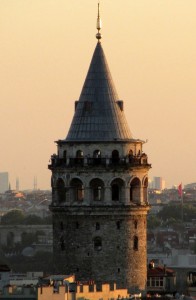 |
| Galata Tower |
Places to go: In roughly descending order of our completely subjective preferences.
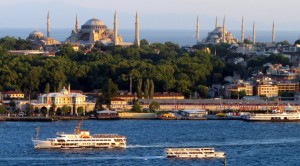 |
| Sultanahmet, seen from Beyoglu: Aya Sofya to the left and the Blue Mosque to the right |
- Sights
- The blockbuster sights are almost all in the old city: Sultanahmet is the name of the area (and tram stop) where you will find the Aya Sofya (20 TL / $13), Blue Mosque (free of charge), Archaeological museum (10 TL / $6-7) (located within the gardens of Topkapı Palace (30 TL for entrance, 15 TL for Harem entrance), and the Basilica Cistern (10 TL). Everything’s quite well marked in the area, and regardless everyone speaks English so you should have no trouble. Aya Sofya is unmissable – be sure to make it up to the second floor for the mosaics! Depending on how much you care about the dent in your wallet, Topkapi palace and its Harem are impressive and tremendously important historically, though the lines can be tedious. The Archaeological Museum has quite simply the best classical sculptures I’ve ever seen – blows anything you can find in New York, London, Athens, or Cairo out of the water. The Basilica Cistern is quite a magical place and a nice respite from the hustle of the city streets.
- The bazaars: The Grand Bazaar (within walking distance of Sultanahmet, or just two stops up the line at Beyazit station) and Spice Bazaar (located near the Yeni Cami or New Mosque at Eminonu tram stop) are just plain fun. If you’ve only got time for one, the Spice Bazaar has just about everything you’ve seen in the grand bazaar and a better vibe. Always haggle for the price – offer half what they ask for and meet somewhere in the middle (never pay more than ¾ of what they first asked).
- You could spend a week (a lifetime?) in the alleyways off of Istiklal Caddesi. I especially like the ones towards the bottom around Galatasaray and Tunel. Go more than two avenues to the northwest (right, if you are walking from Taksim) of Istiklal and you will be in a fast gentrifying but still pretty gritty slum called Tarlabaşi – an interesting place to visit during the day. The alleys on the left (southeast) of Istiklal have interesting junk shops and galleries, those immediately to the right are more full of cafes.
- I lived in Cihangir, a lovely neighborhood renowned for its streetside cafes and bars. It is a picturesque residential area that gentrified about ten years ago and is full of journalists, diplomats, and Turkish soap opera stars. If you wander the back streets you’ll come across antique and second hand clothing stores. It’s a great place to spend an evening. Journey Cafe on Akarsu Yks. and White Mill on Susam Sk. are favorite haunts.
- Istanbul has a fast-developing fine arts scene. Istanbul Modern (12 TL), at the Tophane tram stop, is worth a visit, especially if you can have a glass of wine at the cafe without a cruise ship blocking your view. The Pera Museum (10 TL) is towards the bottom of Istiklal Caddesi and tends to have excellent exhibitions and a good permanent collection of 16th-20th century art as well. Istiklal Caddesi also has a number of new top-notch galleries, with SALT Beyoglu and Arter (both on the southern half of the street) being particular favorites. Tophane is emerging as a gallery hub – start at GalleriNON and roam from there.
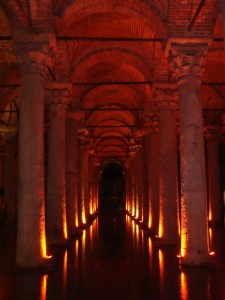 |
| Basilica Cistern |
- Prince’s Islands: Büyükada, or Big Island, is the most popular, but you can get off at any of the four. A ferry from Kabataş to Büyükada takes 1.5 hours, which is very pleasant if the weather is good (and still only costs 3.5 TL on the municipal ferry! There are also a number of private ferry companies that do the same route for 4-7TL). There are no cars on the islands aside from emergency vehicles and there are lovely parks, so it’s a great escape for a nice day (as long as you don’t mind the omnipresent smell of horse). You can ride around in a horse-drawn phaeton or rent bikes or go hiking or just eat some fresh seafood.
- Ortaköy: a nice district a little ways up the Bosphorus, right under the first bridge. There’s a beautiful little mosque, lots of cafes, and a place to hop on a Bosphorus cruise (if you haven’t caught one from Kabataş or Eminonu). It’s probably one of the most photographed locations in Istanbul. You can catch a bus from the shore road (take any that say ‘Ortaköy’ on the side) or take an hour-long walk north along the Bosphorus from Beyoğlu. Along the way from the city center, you can visit Dolmabahce Palace, just north of the Kabataş ferry stop- it is an opulent European-style place whose decoration more or less bankrupted the Ottoman Empire. If you have an International Student Identity card admission is 1TL, without it is 20 TL. You’re required to go through with a (usually excellent) guided tour, included in the price, so budget at least an hour and a half. Lines can be long during peak tourist season and on weekends, and it’s closed Monday and Thursday.
- Rumeli Hisari: This uber impressive fortress in the Sariyer area was built in 1452 to prevent aid from coming down the Bosphorus from the Black Sea during the seige of Constantinople. Amazingly, it was completed in a record time of 4 months and 16 days. My favorite brunch spot in Istanbul, Kale, is located here, under the towers, with breathtaking views of the Bosphorus, and the swanky crowd who tends to frequent the area on lazy Sundays (http://www.kalecafe.com); Also nearby is the Sakip Sabanci Museum (10 TL) which maintains a wonderful permanent collection housed in a stately home on the Bosphorus, as well as an interesting mix of temporary exhibitions. The restaurant on the museum grounds, MuzedeChanga, is a great date spot but probably too out of the way for short-term visitors.
- Kadikoy: If you’re looking for an excuse to “go to Asia,” this is a pleasant way to do it. There are ferries every 15 minutes from Kabatas and Karakoy (right below the Galata bridge, cost 1.65 TL). When you reach the other side, walk towards the tall flag and Ataturk monument, then continue straight across the main road and you’ll find your way to the fish market and Bahariye Caddesi, full of shops and cafes. Nearby the fish market is a lovely (although a bit pungent) and the popular local restaurant, Ciya (http://www.ciya.com.tr/), is a perfect place for a leisurely lunch, and is very reasonably priced.
- Socializing – this so depends on what you’re interested in and willing to spend – but here’s our take on the most well-known options. For more details, see the next blog post.
- Sultanahmet is full of tourist traps and places with little character.
- Taksim has two main areas for evening fun: Nevizade (about halfway down Istiklal) and Asmalimescit.
- Nevizade is a narrow and bustling side street that runs parallel to Istiklal. For an authentic meyhane dinner (much like Greek meze or Spanish tapas), this is the easiest place to go. It can be noisy and crowded, but it is atmospheric and often they play live music.
- Asmalimescit is right at the bottom of Istiklal (just up the hill from Galata, adjacent to Tunel and Pera). Slightly more trendy (and definitely more expensive) than Nevizade but much less hassle.
- The Golden Mile is a string of very ritzy clubs along the Bosphorus just north of the first bridge. They’re beautiful and full of pretty people. The music is variable and the drinks exorbitant; face control is not that strict (don’t wear sneakers, but also don’t expect to have to wait in line very long). Expect to pay a 50 TL cover, even if you’re a pretty girl. Reina, Supper Club, and Angelique are the best known. Not worth it for my money but if you want to see how the Turkish riche party then by all means..
Getting around
Istanbul’s public transit is reliable, cheap, and comprehensive. Taxi drivers are often clueless and the most likely people outside the Grand Bazaar to try and scam you. Try to only take taxis if you know how to get where you’re going or are traveling with someone who does, or if your hotel arranges it for you. If you have GPS on your phone, insist that the driver follows it (he will probably try and tell you that because of traffic you must go another way. You will be in traffic no matter what. Follow the GPS).
You will need a token for the tram, metro, or ferry, but there are vending machines just by the entrance, so no need to provision in advance. If you haven’t gotten a token before getting on the bus, you can give anyone that looks like a resident 2 TL and they will pay for your journey with their Istanbulkart. If you’re going to be taking a lot of public transit, it’s worth buying an Akbil, recently rebranded as Istanbulkart (the names are interchangeable), the Metrocard/CharlieCard/Oystercard of Istanbul (6TL), as the fares are slightly lower. There are kiosks selling Akbils/Istanbulkart at Taksim and Kabatas.
Useful public transit links:
- Hands down the best way to get in/out of the old city from Beyoglu (other than walking if the weather’s good) is to take the tram. To the Golden Horn from Taksim/Beyoglu, go down to the Bosphorus (basically take any road down a hill in an easterly direction) and you will run into the tram. Head south (right) for the old city. Sultanahmet is the stop for Aya Sofya, Blue Mosque, Basilica Cistern, Gulhane for Topkapi Palace and the Archeological Museum and Cemberlitas for the Grand Bazaar and the wonderful Cemberlitas hamam. The northernmost stop is Kabataş, which is connected via funicular to Taksim and is also a key ferry terminal.
- To go up the European Coast, go down to the Bosphorus and catch any bus that says ‘Ortaköy’ (charming district underneath the first bridge, Boğaz bridge), Bebek, Rumeli Hisarı, Istinye, Yeniköy. Lots of people say these districts are very pleasant – with the exception of Ortaköy I don’t think they’ve got much going on. Ortaköy has a beautiful, tiny mosque and lots of nice seaside cafes with shisha and quaint, somewhat touristy shops.
- To the Asian side/Prince’s Islands, go down to the Bosporus and walk north (left) until you hit Kabataş. There are a number of ferry terminals – go to someone official looking and say your destination (Uskuder or Kadiköy for the Asian side, Buyukada for the Prince’s Islands) and they will point you in the direction of the right one.
Language Basics
Turkish Pronunciation
C = J so Cihangir = jee-hahn-gear and Cami (mosque) = jah-mee
İ = ee so İstanbul = Ee-stahn-bool
Ş = sh so beş (five) = besh
Ğ = not pronounced, so Beyoğlu = Beyohloo
ı = uh so Topkapı Sariyer (Topkapı Palace) is Tohp-kah-puh Sah-ree-yehr
Key phrases
Yes/no = evet/hayir
Teşek kurler = thank you
… nerede? = Where is ….?
Ne kadar? = how much?
1/2/3/4/5/10 = bir/iki/uç/dört/beş/on
Places to go outside the city:
Turkey is a large, gorgeous, and SAFE country that is well worth exploring. Buses are usually the cheapest way to get around but flights can be cheaper (!) and are certainly a better bargain time-wise. More on this can be found in the doc linked at the top of this entry and will be written up soon…
